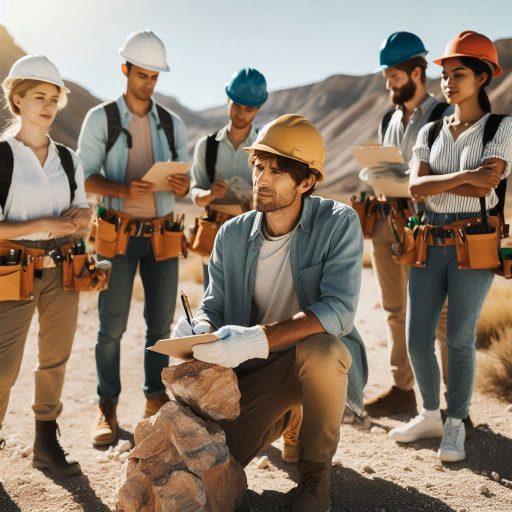Introduction
Geology is the study of the Earth’s structure, composition, and processes. Environmental conservation involves protecting and preserving natural resources.
Understanding geology is crucial for environmental conservation as it helps in identifying and managing natural hazards such as landslides and earthquakes.
Furthermore, studying geology provides insights into the distribution of minerals and water resources, which are essential for sustainable development.
By analyzing rock formations and fossils, geologists can determine past environmental conditions, leading to better conservation strategies for the future.
Geological mapping helps in locating potential sites for energy extraction and waste disposal, ensuring minimal impact on the environment.
Geological knowledge also aids in assessing the impact of human activities on the environment, such as mining and deforestation.
Through geological surveys, scientists can monitor changes in the landscape and develop conservation plans to prevent soil erosion and habitat destruction.
Overall, geology plays a critical role in environmental conservation by providing essential data and tools to make informed decisions for the sustainable management of natural resources.
Geological processes that impact environmental conservation
Geological Processes and Their Environmental Impact
Most importantly, geological processes play a crucial role in shaping our environment.
Erosion, weathering, and volcanic activity significantly influence landforms, ecosystems, and natural resources.
Each process contributes to the ongoing changes in the Earth‘s surface and affects how we manage our environment.
Examples of how these processes can lead to environmental degradation or conservation efforts
Erosion and Its Effects
Erosion is the process by which soil and rock are removed from one location and transported to another.
Water, wind, and ice are the primary agents of erosion.
For instance, riverbanks can erode due to heavy rainfall, leading to loss of soil and habitat.
This degradation often results in sedimentation in nearby water bodies, affecting water quality.
In coastal areas, erosion can undermine shorelines and result in loss of valuable ecosystems like wetlands and mangroves.
In some cases, erosion can lead to conservation efforts.
For example, recognizing the impact of soil erosion in agricultural areas has prompted the implementation of sustainable farming practices.
Techniques like contour plowing and terracing help reduce erosion and protect soil quality.
These methods not only conserve the land but also enhance agricultural productivity.
Weathering and Its Role
Weathering involves the breakdown of rocks into smaller particles through chemical, physical, and biological processes.
This process influences soil formation and nutrient cycling.
For instance, chemical weathering can release essential minerals into the soil, promoting plant growth.
However, excessive weathering can lead to soil depletion and desertification.
Areas suffering from severe weathering often face challenges in maintaining vegetation.
This loss can result in increased erosion and habitat destruction.
Conservationists work to restore these areas by planting native vegetation.
This helps stabilize the soil and promotes biodiversity.
Volcanic Activity and Its Impact
Volcanic activity profoundly affects the environment.
Eruptions can devastate landscapes, destroy habitats, and release ash and gases into the atmosphere.
The 1980 eruption of Mount St. Helens is a prime example.
The eruption caused significant destruction, but it also created opportunities for ecological recovery.
Over time, new ecosystems developed in the volcanic ash, demonstrating nature‘s resilience.
Volcanic soils, rich in nutrients, can enhance agricultural productivity.
Regions near volcanoes often have fertile lands that support diverse crops.
This agricultural benefit can encourage conservation practices, such as sustainable farming methods, to protect these valuable soils.
Understanding geological processes is essential for effective environmental conservation.
Erosion, weathering, and volcanic activity significantly impact ecosystems and natural resources.
By recognizing the dual nature of these processes, we can develop strategies for both environmental conservation and restoration.
Sustainable practices can mitigate the negative effects of geological processes while promoting healthy ecosystems.
Emphasizing the connection between geology and environmental conservation is vital for fostering a sustainable future.
Role of geologists in environmental conservation
Geologists Play a Crucial Role in Assessing and Monitoring Environmental Impacts
Geologists are essential to understanding and mitigating the environmental impacts of human activities.
They analyze the earth’s physical processes and assess how natural and human-induced factors affect ecosystems.
Their expertise helps identify areas vulnerable to environmental degradation, such as soil erosion, groundwater contamination, and seismic activity.
By studying rock formations, groundwater flow, and soil composition, geologists can predict potential hazards and assess risks.
For example, before major construction projects like dams or highways, geologists conduct environmental impact assessments.
These evaluations help determine whether the project could lead to harmful changes in the environment.
Monitoring environmental impacts is another critical task for geologists.
They use advanced tools to track shifts in landforms, groundwater levels, and soil stability over time.
This continuous monitoring allows them to detect early warning signs of environmental issues, enabling timely interventions.
Geologists also play a role in managing the aftermath of natural disasters.
After events such as earthquakes or landslides, geologists assess the damage and recommend mitigation measures.
This assessment ensures that recovery efforts prioritize environmental sustainability while reducing future risks.
Additionally, geologists collaborate with environmental scientists to analyze pollution levels in the air, water, and soil.
Their findings inform strategies to reduce pollution and protect ecosystems.
Without their expertise, many environmental protection initiatives would lack the necessary scientific foundation for effective action.
Geologists Contribute to Sustainable Resource Management and Land Use Planning
Sustainable resource management depends heavily on geologists.
They help identify and evaluate natural resources like minerals, fossil fuels, and water while ensuring minimal environmental harm.
By understanding the composition and distribution of earth materials, geologists can guide responsible resource extraction that reduces environmental impact.
Geologists work with policymakers to create land use plans that balance development and conservation.
They ensure that mining, agriculture, and urban expansion occur in ways that protect sensitive ecosystems.
Through careful planning, geologists help avoid overexploitation of resources, promoting long-term sustainability.
For example, when planning water management strategies, geologists study groundwater and surface water interactions.
This understanding ensures that water resources are used efficiently without depleting vital ecosystems.
Geologists’ contributions are vital to safeguarding freshwater supplies, especially in areas prone to droughts or contamination.
In energy production, geologists play a pivotal role in finding sustainable alternatives.
They explore the potential of geothermal energy, a renewable resource that relies on the earth‘s natural heat.
By identifying locations suitable for geothermal plants, geologists support the shift toward clean energy sources, reducing reliance on fossil fuels.
Geologists also help manage land affected by human activity.
In urban areas, they assess soil stability to ensure safe construction.
In rural regions, they advise on sustainable agricultural practices that maintain soil fertility and prevent erosion.
Their expertise ensures that land is used efficiently while minimizing environmental degradation.
In fact, geologists are key players in environmental conservation.
Their work in assessing environmental impacts and promoting sustainable resource management helps protect the planet for future generations.
Read: Key Roles and Responsibilities of a Chemist in the US
Geological formations and their impact on ecosystems
How different types of geological formations, such as mountains, rivers, and caves, influence biodiversity
Influence of Mountains on Biodiversity
Mountains are among the most diverse geological formations.
They create distinct microclimates that support various species.
Elevation changes result in different temperature and moisture levels, fostering unique ecosystems.
For example, the Rocky Mountains in the USA host diverse flora and fauna, including endemic species not found elsewhere.
These ecosystems provide essential resources, such as water and food, for many organisms.
Mountain ranges also act as barriers, influencing migration patterns of animals.
This isolation leads to species adaptation and evolution, contributing to biodiversity.
Preserving mountain ecosystems is vital for maintaining these unique species and their habitats.
Role of Rivers in Ecosystem Health
Rivers are crucial geological features that shape landscapes and influence biodiversity.
They provide essential habitats for aquatic and terrestrial species.
Freshwater ecosystems support diverse life forms, including fish, amphibians, and plant species.
The presence of rivers can enhance soil fertility through sediment deposition, promoting lush vegetation along their banks.
Rivers also serve as migration corridors for wildlife, connecting different habitats.
This connectivity is vital for species that rely on seasonal migrations.
However, human activities like dam construction and pollution threaten river ecosystems.
Conserving rivers is essential for sustaining biodiversity and ensuring ecosystem health.
Caves as Biodiversity Hotspots
Caves represent another critical geological formation influencing biodiversity.
They offer unique habitats for specialized species, such as bats, insects, and unique microorganisms.
The stable temperatures and humidity levels in caves create ideal conditions for these organisms.
Caves also play essential roles in nutrient cycling and water filtration.
They serve as natural reservoirs, influencing groundwater quality and availability.
However, cave ecosystems are fragile and vulnerable to human activities.
Pollution, habitat destruction, and climate change threaten these unique environments.
Importance of Conserving Geological Formations
Conserving geological formations is vital for ecosystem stability.
Each formation contributes uniquely to the overall health of the environment.
Protecting mountains, rivers, and caves ensures that diverse species continue to thrive.
These formations provide critical resources, such as clean water, food, and habitats.
Moreover, geological formations contribute to climate regulation.
Forests on mountains absorb carbon dioxide, while rivers help maintain local climates.
Healthy ecosystems can buffer against climate change impacts, benefiting all life forms.
Conservation efforts must prioritize preserving these geological features.
Implementing protected areas and sustainable management practices helps safeguard biodiversity.
Educating communities about the importance of geological formations fosters a sense of stewardship.
Engaging local populations in conservation efforts ensures long-term success.
Geological formations like mountains, rivers, and caves significantly impact biodiversity and ecosystem stability.
Each formation plays a crucial role in supporting diverse life forms and maintaining environmental health.
Conserving these geological features is essential for sustainable ecosystems and the overall well-being of our planet.
By understanding their importance, we can take meaningful steps toward protecting our natural heritage for future generations.
Read: Earning Potential: Chemist Salaries Across US States
Transform Your Career Today
Unlock a personalized career strategy that drives real results. Get tailored advice and a roadmap designed just for you.
Start NowGeological hazards and their mitigation for environmental conservation
Common Geological Hazards
Geological hazards pose significant risks to both the environment and human populations.
Earthquakes are among the most destructive natural disasters.
They occur due to the movement of tectonic plates beneath the Earth’s surface.
Even moderate earthquakes can cause substantial damage to infrastructure and the environment.
Landslides represent another serious geological hazard.
They happen when rock or soil suddenly collapses down a slope.
Heavy rainfall, earthquakes, and human activities can trigger landslides.
These events can destroy habitats, pollute water sources, and threaten human lives.
Sinkholes also pose a significant risk, particularly in limestone regions.
They form when underground cavities collapse, causing the ground above to sink.
Sinkholes can damage homes and roads, disrupt ecosystems, and create hazardous conditions.
Understanding these geological hazards is crucial for effective environmental conservation.
Awareness of these risks allows communities to prepare and implement strategies to mitigate their impacts.
Strategies for Mitigating Geological Hazards
Mitigating geological hazards requires a proactive approach that combines education, planning, and engineering.
First, conducting thorough geological assessments is essential.
These assessments identify areas at risk for earthquakes, landslides, or sinkholes.
This information helps communities prioritize mitigation efforts.
One effective strategy for earthquake preparedness involves building codes.
Enforcing strict building codes ensures that structures can withstand seismic activity.
Retrofitting older buildings also enhances their resilience against earthquakes.
Communities should conduct regular drills to educate residents about earthquake safety.
For landslide mitigation, effective drainage systems play a vital role.
Properly managing rainwater runoff reduces the risk of soil saturation.
Planting vegetation on slopes stabilizes the soil and helps prevent landslides.
These plants absorb water and their roots anchor the soil in place.
In areas prone to sinkholes, land use planning is crucial.
Avoiding construction in high-risk areas can prevent damage and loss.
Additionally, monitoring underground water levels can help identify potential sinkhole formation.
Implementing responsible water management practices minimizes the risk of sinkholes developing.
Community Education and Involvement
Community education and involvement are vital in hazard mitigation.
Local governments should conduct outreach programs to raise awareness about geological hazards.
Workshops can educate residents on identifying risks and preparing emergency plans.
Engaging the community fosters a sense of responsibility.
Encouraging residents to participate in mitigation efforts helps build resilience.
Citizens can assist in monitoring local geological conditions and reporting changes.
Collaboration between geologists, environmentalists, and urban planners is essential.
This interdisciplinary approach allows for comprehensive hazard assessments and effective mitigation strategies.
By integrating geological insights into urban planning, communities can minimize risks and protect the environment.
Geological hazards like earthquakes, landslides, and sinkholes threaten both the environment and human populations.
Understanding these risks is essential for effective mitigation.
Communities can implement various strategies to minimize damage and protect lives.
Through education, planning, and collaboration, societies can build resilience against geological hazards.
Read: Top Chemistry Departments and Schools in the US

Discover More: Internship Opportunities for Toxicology Students
Geological resources and sustainable use
Extraction and Use of Geological Resources
Geological resources play a vital role in our daily lives.
Minerals, fossil fuels, and water are essential for various industries.
The extraction of these resources supports economic development and infrastructure growth.
However, this process can have significant environmental impacts.
Mining operations extract minerals like copper, gold, and lithium.
These materials are crucial for electronics, construction, and renewable energy technologies.
The extraction process often disrupts ecosystems, leading to habitat destruction.
Additionally, mining can result in soil erosion and water pollution.
Fossil fuels, including coal, oil, and natural gas, remain the primary energy sources globally.
Their extraction involves drilling and mining, which can cause land degradation and air pollution.
Burning fossil fuels releases greenhouse gases, contributing to climate change.
This impact highlights the urgent need for alternative energy sources and practices.
Water, another essential geological resource, is vital for human survival and agriculture.
However, excessive extraction can deplete aquifers and harm aquatic ecosystems.
Over-extraction leads to reduced water quality and availability for future generations.
Balancing water use with conservation is critical to maintaining this essential resource.
Importance of Sustainable Practices
Sustainable practices are crucial for mitigating environmental degradation.
Responsible resource management can reduce the negative impacts of extraction.
Sustainable mining techniques minimize habitat disruption and pollution.
Companies can adopt practices like land rehabilitation and waste reduction.
In fossil fuel extraction, transitioning to cleaner energy sources is vital.
Renewable energy options like solar, wind, and geothermal reduce reliance on fossil fuels.
Investing in these alternatives supports environmental conservation and promotes long-term sustainability.
Governments and industries must prioritize renewable energy to protect ecosystems.
Water conservation practices also play a significant role in sustainability.
Implementing efficient irrigation methods reduces water waste in agriculture.
Promoting rainwater harvesting can help communities collect and store water sustainably.
Education on responsible water use encourages individuals to conserve this precious resource.
Promoting Conservation
Geologists can contribute significantly to environmental conservation.
They possess the expertise needed to assess resource availability and sustainability.
By conducting thorough geological surveys, they can identify areas suitable for responsible extraction.
Their work helps ensure that natural resources are utilized efficiently and sustainably.
Collaboration between industries and environmental organizations is essential.
Joint efforts can lead to the development of sustainable practices and technologies.
Engaging local communities in resource management promotes awareness and stewardship.
When communities understand the value of their resources, they become more invested in conservation efforts.
Regulatory frameworks also play a vital role in promoting sustainable practices.
Governments must enforce laws that protect geological resources and ecosystems.
Implementing strict regulations on mining, drilling, and water extraction helps prevent environmental degradation.
These measures safeguard natural resources for future generations.
The extraction and use of geological resources are integral to human progress.
However, unsustainable practices can lead to environmental degradation.
Embracing sustainable resource management is essential for promoting conservation.
By prioritizing responsible practices, we can ensure that geological resources remain available for future generations.
Through collaboration and regulation, we can protect our planet while meeting society’s needs.
Read: How to Become a Licensed Chemist in the USA: Steps and Tips
Discover More: Seismology Data Analysis: Methods and Techniques
Delve into the Subject: How to Gain Field Experience in Geology
Case studies of successful conservation measures based on geology
Examples of Conservation Projects Utilizing Geology
Geology plays a critical role in various conservation projects around the globe.
One notable example is the restoration of the Chesapeake Bay.
Researchers studied sediment deposits to understand nutrient pollution sources.
By identifying these sources, they implemented targeted strategies to reduce runoff and improve water quality.
Another impactful project is the rewilding of the Scottish Highlands.
Geologists mapped the landscape to restore natural habitats.
They identified essential geological features that support biodiversity.
This approach helped reintroduce native species and improved ecosystem health.
In California, the San Francisco Bay Wetlands Restoration Project illustrates geology’s role in conservation.
Experts analyzed historical geological data to restore tidal marshes.
They focused on sediment types and historical water flow patterns.
These insights enabled effective restoration of wetlands, benefiting both wildlife and local communities.
In Africa, the Great Green Wall initiative aims to combat desertification.
Geologists contribute by assessing soil types and moisture levels.
This data helps identify suitable areas for planting trees and restoring ecosystems.
The project has shown success in increasing vegetation cover and improving local climates.
Analyzing Effectiveness of Conservation Measures
Evaluating the effectiveness of these geological conservation projects reveals valuable insights.
In the Chesapeake Bay project, water quality improvements demonstrate the power of targeted interventions.
Reduced nutrient runoff led to healthier aquatic ecosystems.
This project highlights the importance of using geological data for effective conservation strategies.
The Scottish Highlands restoration project showcases the need for geological mapping.
By understanding the landscape, conservationists restored habitats more effectively.
Increased biodiversity and healthier ecosystems resulted from informed planning.
This success emphasizes the importance of integrating geology into conservation efforts.
The San Francisco Bay Wetlands Restoration Project has achieved impressive results.
The restored tidal marshes improved flood protection and enhanced wildlife habitats.
Geologists‘ insights into sediment dynamics and water flow were crucial for success.
This project illustrates how geology can guide effective restoration practices.
The Great Green Wall initiative demonstrates the power of geological assessments.
By focusing on soil and moisture conditions, the project targeted areas for successful reforestation.
Increased vegetation has improved local ecosystems and provided livelihoods for communities.
This success emphasizes the importance of geological knowledge in combating desertification.
Lessons Learned for Future Conservation Efforts
These successful projects highlight essential lessons for future conservation efforts.
First, integrating geological data into conservation planning is crucial.
Understanding the landscape‘s geology enhances the effectiveness of restoration measures.
Second, collaboration among geologists, ecologists, and community members is vital.
Engaging local communities ensures that conservation projects address their needs and knowledge.
This collaboration fosters a sense of ownership and commitment to the projects.
Finally, monitoring and adaptive management are essential.
Continually assessing the impact of conservation measures allows for adjustments.
This flexibility enhances project effectiveness and ensures long-term success.
On a final note, geology significantly impacts environmental conservation.
Successful projects around the world illustrate the importance of geological knowledge.
These efforts not only restore ecosystems but also provide valuable lessons for future conservation strategies.
Conclusion
Geology plays a vital role in environmental conservation.
Understanding geological processes helps identify natural resources and assess potential environmental impacts.
Geologists study soil composition, rock formations, and groundwater, all crucial for sustainable land management.
Their insights guide conservation strategies, especially in areas prone to erosion or natural disasters.
Geology also informs habitat preservation efforts.
By understanding landforms and geological features, conservationists can protect ecosystems effectively.
Knowledge of geological history aids in assessing climate change impacts and helps develop adaptive strategies for vulnerable regions.
However, addressing environmental challenges requires interdisciplinary cooperation.
Geologists and environmental conservationists must work together to create comprehensive solutions.
Each field brings unique perspectives and expertise.
Geologists provide essential data about Earth’s processes, while conservationists focus on protecting biodiversity and ecosystems.
Collaboration leads to innovative approaches for managing natural resources sustainably.
Regular communication between these disciplines fosters understanding and aligns goals.
Together, they can create effective strategies to combat issues like habitat destruction and climate change.
By emphasizing the importance of geological knowledge, conservationists can develop targeted initiatives.
It‘s crucial to bridge the gap between geology and environmental conservation for a sustainable future.
Let‘s work together to protect our planet for generations to come.
[E-Books for Sale]
The Big Book of 500 High-Paying Jobs in America: Unlock Your Earning Potential
$19.99 • 500 High-Paying Jobs • 330 pages
Explore 500 high-paying jobs in America and learn how to boost your career, earn more, and achieve success!
See All 500 High-Paying Jobs of this E-Book
1001 Professions Without a Degree: High-Paying American Jobs You Can Start Now
$19.99 • 1001 Professions Without a Degree • 174 pages
Discover 1001 high-paying jobs without a degree! Unlock career tips, skills, and success strategies for just $19.99!




